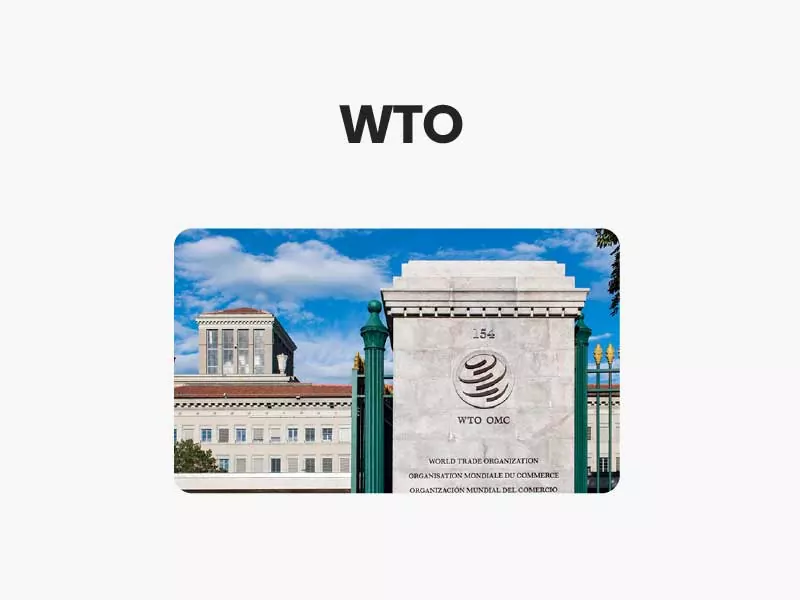Companion@360 → 7 Month programme to sharpen your writing skills → REGISTER NOW

Export Subsidies In India And WTO Guideline
WTO
- The World Trade Organization (WTO) is the only global international organization dealing with the rules of trade between nations.
- At its heart are the WTO agreements, negotiated and signed by the bulk of the world’s trading nations and ratified in their parliaments.
- The goal is to ensure that trade flows as smoothly, predictably and freely as possible.
- The WTO has many roles: it operates a global system of trade rules, it acts as a forum for negotiating trade agreements, it settles trade disputes between its members and it supports the needs of developing countries.
- All major decisions are made by the WTO’s member governments: either by ministers (who usually meet at least every two years) or by their ambassadors or delegates (who meet regularly in Geneva).
- The primary purpose of the WTO is to open trade for the benefit of all.
- India is one among the founding member of WTO which came into existence on January 1,1995 replacing GATT(General agreement on tariffs and Trade).
- It was created with six major objectives:
- Setting and enforcing rules for international trade
- Serving as a forum for negotiating trade liberalization
- Resolving trade disputes
- Increasing transparency of the decision-making process in international trade
- Engaging with other international economic institutions for facilitating economic management
- Facilitating the developing countries to gain the full benefit of the global trading system. India has a commitment towards fulfilling these objectives by implementing any norm or recommendation developed by WTO and any unwillingness has to be conveyed to the organization or proper reservations have to be made in this regard.
Export subsidies
- The cores of the reform programme on export subsidies are the commitments to reduce subsidized export quantities, and the amount of money spent subsidizing exports. The Agriculture Agreement also looks at anti-circumvention questions.
- The right to use export subsidies is now limited to four situations:
- Export subsidies subject to product-specific reduction commitments within the limits specified in the schedule of the WTO Member concerned
- Any excess of budgetary outlays for export subsidies or subsidized export volume over the limits specified in the schedule which is covered by the “downstream flexibility” provision of Article 9.2(b) of the Agreement on Agriculture
- Export subsidies consistent with the special and differential treatment provision for developing country Members (Article 9.4 of the Agreement)
- Export subsidies other than those subject to reduction commitments provided that they are in conformity with the anti-circumvention disciplines of Article 10 of the Agreement on Agriculture. In all other cases, the use of export subsidies for agricultural products is prohibited (Articles 3.3, 8 and 10 of the Agreement).
Read Also National Nutrition Mission
India’s Disputes At WTO
- The WTO’s dispute settlement panel ruled that India’s export subsidy schemes, including the provision for special economic zones, violated core provisions of global trade norms.
- The US in March 2018 challenged export subsidies provided by India under five sets of schemes:
- Export-Oriented Units, Electronics Hardware Technology Park and Bio-Technology Park (EOU/EHTP/BTP) Schemes
- Export Promotion Capital Goods (EPCG) Scheme
iii. Special Economic Zones (SEZ) Scheme
- Duty-Free Imports for Exporters Scheme (DFIS)
- Merchandise Exports from India Scheme (MEIS)
- The export subsidies under most of the challenged schemes, except for MEIS, consist of exemptions and deductions from customs duties and other taxes.
- The US argued these subsidies were a detriment to American workers and manufacturers.
- When consultations with India did not work out, the US in May 2018 requested that a dispute settlement panel be set up.
- India was among the 20 developing countries included in Annex VII of the Agreement on Subsidies and Countervailing Measures (SCM Agreement). This allowed it to use export subsidies as long as per capita Gross National Product (GNP) had not crossed $1,000, at constant 1990 dollars, for 3 consecutive years.
- This was provided to the developing countries for phasing out export subsidies. It is an exception under the “special and differential treatment”. India thus had the flexibility to use export subsidies until 2015.
- The US had earlier accused India of giving prohibited subsidies to Indian steel producers, pharmaceuticals, chemicals, information technology, textiles and apparel.
- While the panel ruled in favour of the US and urged India to withdraw the subsidies without delay.
- While the panel upheld most of the claims made by the US, it rejected some points pertaining to a subset of exemptions from customs duties and an exemption from excise duties.
- Under the various schemes, domestic companies are currently receiving billions in subsidies on an annual basis. Withdrawing the subsidies may have a significant effect on the performance of such companies.
Conclusion
- The WTO dispute settlement panel has asked India to withdraw the concerned export subsidy schemes within a time period of 90 days from the adoption of the report.
- It also asked India to withdraw prohibited subsidies under the EOU/EHTP/BTP schemes, EPCG and MEIS, within a period of 120 days and SEZ scheme within 180 days.
- India has a month to appeal against the WTO’s order.
- However, India has the right to challenge the ruling before the appellate body of the WTO dispute settlement mechanism with regards to export subsidy schemes.
